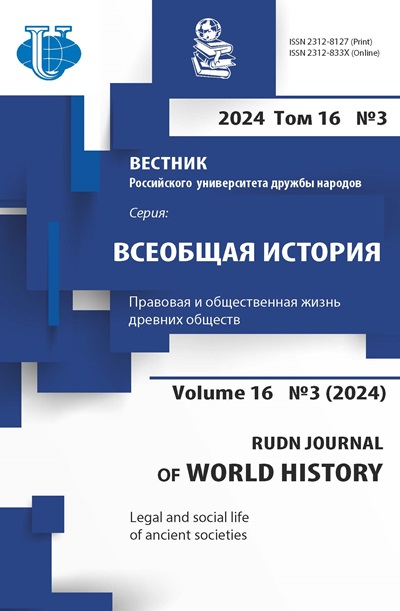No 3 (2014)
- Year: 2014
- Articles: 9
- URL: https://journals.rudn.ru/world-history/issue/view/109
Articles
MAIN MISCONCEPTIONS OF OUR TIME: FROM THE REFORMATION TO NEOLIBERALISM. PREHISTORY AND FIRST STEPS
Abstract
The author of this article tries to find out the origins of of the genesis and evolution of the modern neo-liberal ideology. The purpose of the work is to examine the development of the western axiological project from the Reformation, the Enlightenment, Ethics neoliberal capitalism to the concept of the modern global world.
RUDN Journal of World History. 2014;(3):5-31
 5-31
5-31


POWER - IS WHAT IS NEVER ENOUGH. ABOUT THE NATURE AND TYPOLOGY OF POLITICAL LEADERSHIP, TYPES OF POLITICAL SYSTEMS AND REGIMES IN THE HISTORICAL PROCESS
Abstract
The author tries to explain the basic methodological approaches to the problem of political leadership, formed in historical science and political science. The author examines the classification, phenomenology strong leadership, charisma concept of Max Weber, separate stops on the typology of political systems. He opposes the so-called democratic transition and globalization of the world under the auspices of a State monopoly.
RUDN Journal of World History. 2014;(3):32-57
 32-57
32-57


THE FLAVIAN DYNASTY AND THE ROMAN LAND CADASTER
Abstract
The Flavian dynasty had systematically affected all the standards of the Augustus’. Guided by special “law of land pieces” - ius subsecivorum , which was developed by Augustus, Vespasian organized in Italy a large-scaled census of territories. Its task was to reveal some pieces of land, which were illegally occupied, and to sell them for benefit of the fiscus. The results of this inspection showed that the agrarian situation in Italy was so tangled, so even ius subsecivorum did not guarantee that the status publicu s would be observed. Vespasian and Titus transferred this inspection on the ager publicus of the veterans’ colonies in the provinces, so, they supplemented the fiscus. After analysis of the controversial status of different kinds of territories in Italy, Domitian made a crucial decision to grant all the land pieces to their owners and to transform these rests of publicus into private property, abolishing the variety of juridical categories on the Italian territories.
RUDN Journal of World History. 2014;(3):58-66
 58-66
58-66


SUFI’S CONCEPTION OF THE ELECTION ( WILAYA) IN THE TEXTS OF IBN ‘ARABI «ABOUT STAY OF ELECTION ( WILAYA) AND ITS MYSTERIES» AND CRITICISING OF THIS CONCEPTION IN THE TEXT «ABOUT A MAN INTENDING TO VISIT ONE OF THE TOMBS OF SAINTS» OF IBN TAIMIYA
Abstract
The article is devoted to finding the reasons of the conflict between two currents in islamic thought - Salafism and Sufism. The author analyzes the excerpts from of works of Sufi follower Ibn ‘Arabi and Salafi thinker Ibn Taimiya and talks about muslim practice of visiting tombs of saint people and about conception of the election.
RUDN Journal of World History. 2014;(3):67-84
 67-84
67-84


CENSERS FROM ZUNDA-TOLGA (REP. KALMYKIA)
Abstract
Catacomb burials from Zunda-Tolga conclude censers - special ceramic vessels that become the indicator of Eastern Manych catacomb culture in the North-Western Caspian steppe. Typological and stratigraphic analysis permits to determine four periods of evolution of censers in funeral rite of Middle Bronze age people.
RUDN Journal of World History. 2014;(3):85-100
 85-100
85-100


TRANSFORMATION OF THE SCYTHIAN-SIBERIAN CULTURAL TRADITION OF BRONZE AGE (TO THE ISSUE OF SINO-CENTRAL ASIAN CULTURAL CONTACTS)
Abstract
The problem of interaction between the peoples of Central Asia and China, which was manifested in the transformation of the Scythian-Siberian art of the Bronze Age, can clearly be seen in the archaeological material. Classification of the Scythian-Siberian art finds an affinity Scythian, Central Asian and Chinese "art forms" and gives the right to assume that Karasuk culture, tradition Yin style, images Tagar culture, Ordos cultural tradition is closely related. The archeological evidence suggest the movement of cultures of bronze metallurgical industry and animal style through the steppe zone and the Central Asian deserts to the bend of the Yellow River. Penetration of the Scythian-Saka tribes that resided in Inner Mongolia can be traced to the north of the Yellow River.
RUDN Journal of World History. 2014;(3):101-113
 101-113
101-113


CHINESE EMPIRE AND ITS NOTHERNWEST BORDERS IN XVII-XVIII CENTURIES
Abstract
The article analyzes the relations between China, Tibet, Mongolia and Zunghar khanate and its diplomatic tools during the end of XVII-XVIII centuries. Author researches the peaceful and violent measures used to achieve foreign policy goals by the Qing Dynasty. The author emphasizes the important role of Buddhism, blood ties and receptions of the emperor as a tool of subjugation of the Mongols and other bordering nations.
RUDN Journal of World History. 2014;(3):114-124
 114-124
114-124


“MODERATE ISLAMISM” IN TUNISIA AND EGYPT AFTER “THE ARAB SPRING” (2011). Review: M.F. Vidyasova, T.I. Gasanbekova. The Janus-faced moderate Islamism. The post-revolutionary political struggle in Tunisia and Egypt. - M., 2013. - 140 p.
RUDN Journal of World History. 2014;(3):125-129
 125-129
125-129


OUR AUTHORS
RUDN Journal of World History. 2014;(3):130
 130
130
















